How to Change the Windows Media Player Album Options - cochranwastat
Get Help With Windows Media Player In Windows 10

This Itechguide teaches you different ways to get help with Windows Media player in Windows 10. The guide starts by teaching you how to open Windows Media Player.
In the second section, you will learn how to reinstall Windows Media Player if it is not available in Windows 10. Furthermore, the guide covers other topics like changing Media Player options, adding and removing music from the Library, and more.
This Windows 10 Windows Media Player guide contains a number of topics. To find the Windows Media Player help topic you need, expand "Browse Post Topics" below, then click on the topic you need. However, if you are new to Windows Media Player in Windows 10, you can read through the whole guide. The estimated time to read the entire article is about 35 minutes.

The most logical place to start this Windows 10 Media Player help guide is to show you different ways to open Windows Media player. This section teaches you three methods to open Windows Media Player in Windows 10.
If you are not able to open Windows Medial Player with any of the methods below, try uninstalling and reinstalling the app with the steps in the next section – How To Reinstall Windows Media Player In Windows 10 (link opens on this page – takes you to the toipc)
How To Open Windows Media Player From Windows 10 Search
The fastest method to open Windows Media Player is via search. Here are the steps.
- Enter media player into the Windows 10 search box found at the bottom left of the Taskbar – usually close to the Start Menu.
- Then, from the search results, click Windows Media Player.
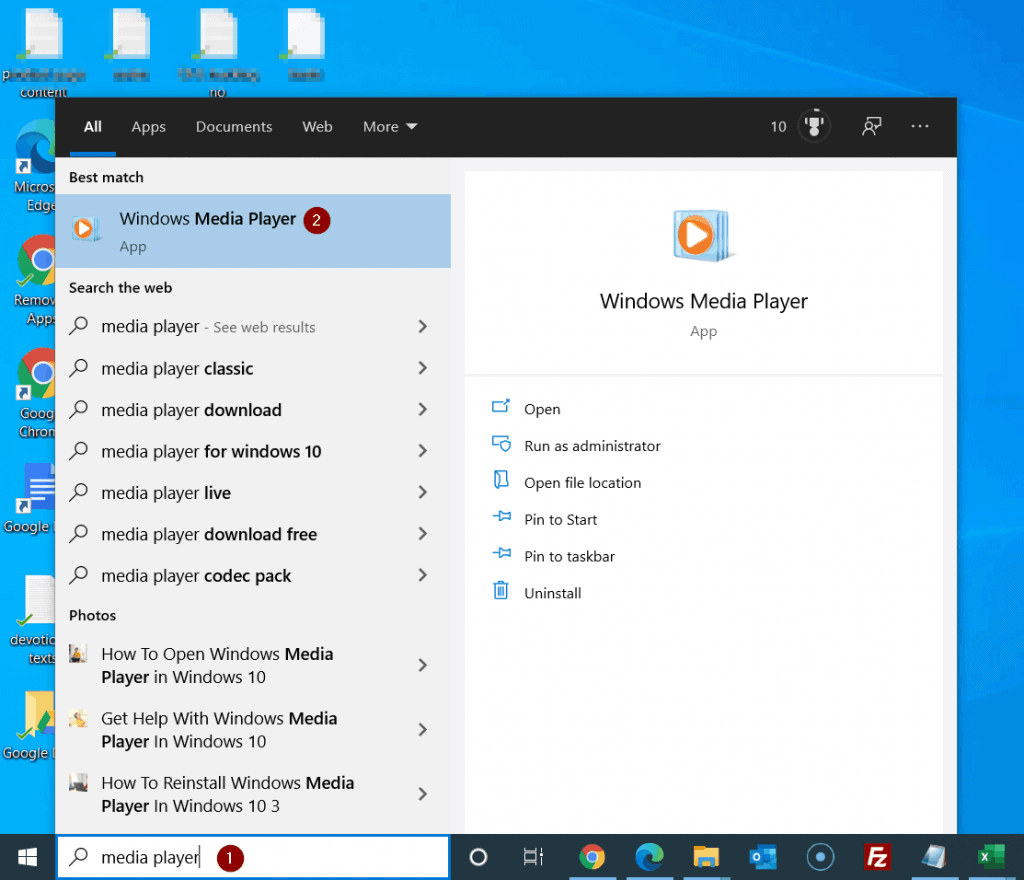
Another method to open Windows Media Player is via the Start Menu. Follow the steps below to open Windows Media Player with this method:
- Click the Start Menu.

- Then, scroll down to the Start Menu items starting with W, locate Windows Media Player, and click it. If Windows Media Player is not displayed on its own, locate Windows Accessories and expands it. Then, click Windows Media Player.


How To Open Windows Media Player From Run
You can also open Windows Media Player via the Run command. Here are the steps:
- Right-click Start Menu and select Run.
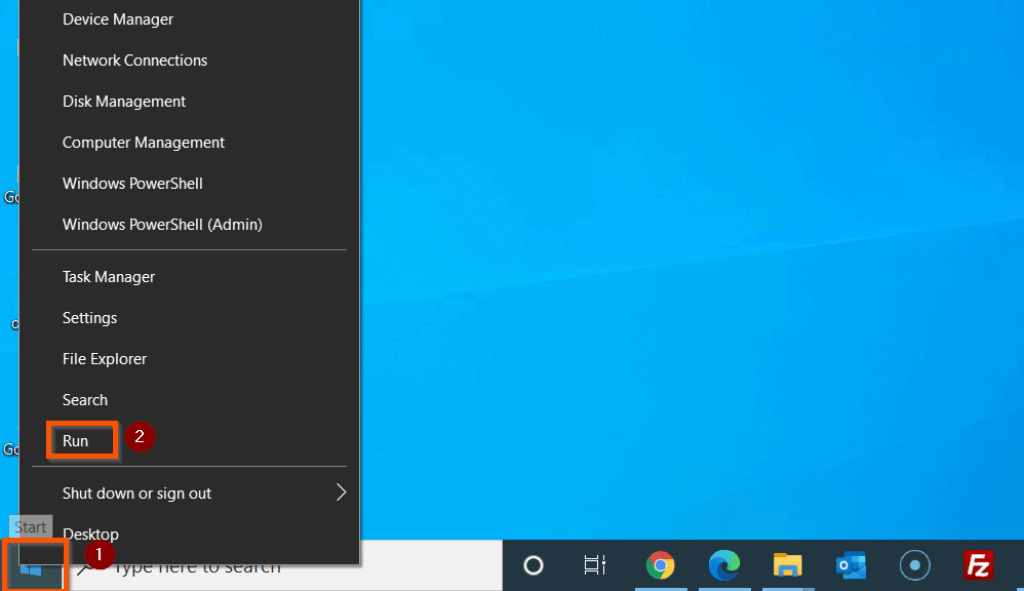
- Then, when Run opens, enter wmplayer.exe and click OK.

Set Up Windows Media Player For First Time Use
When you open Windows Media Player for the first time, it displays Welcome to Media Player with 2 setup options – Recommended settings and Custom settings. Select Custom settings and click Next.


Then, on the final screen, click Finish.


When I started writing this Windows 10 Media Player help guide, I tried opening Windows media player but couldn't find the app.
Moreover, none of the methods of opening Windows Media Player discussed in the last section worked. If you tried opening Windows Media Player but can't find the app, follow the steps below to reinstall the app.
- Right-click the Start Menu and select Settings.

- Then, on the Windows 10 Settings screen, click Apps.
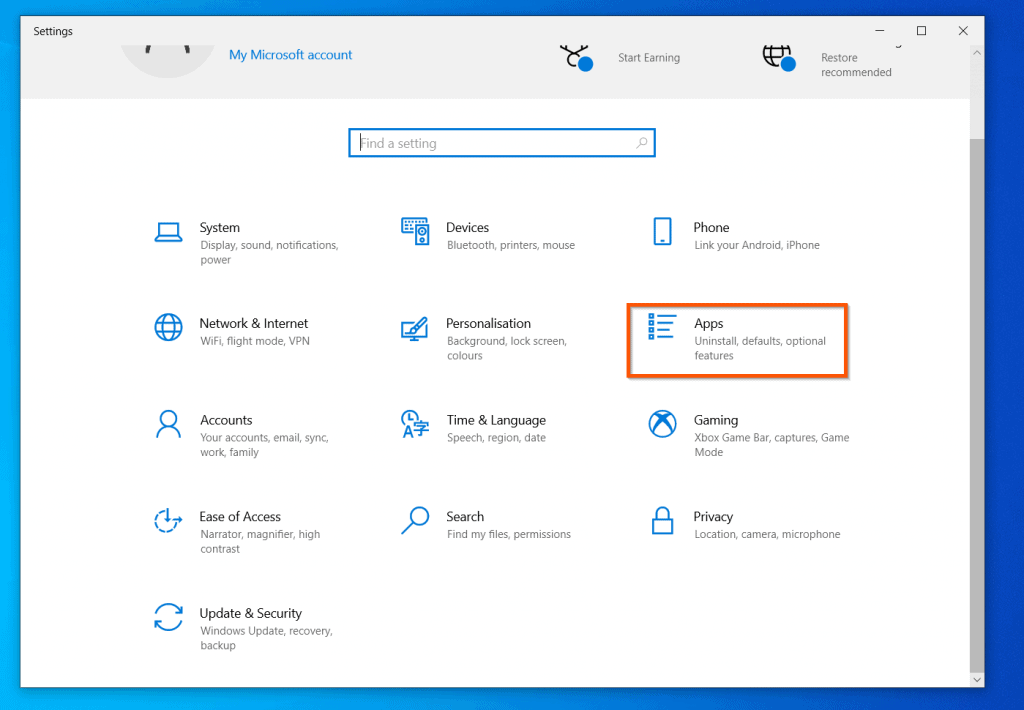
- On the Apps & features screen, click Optional features.
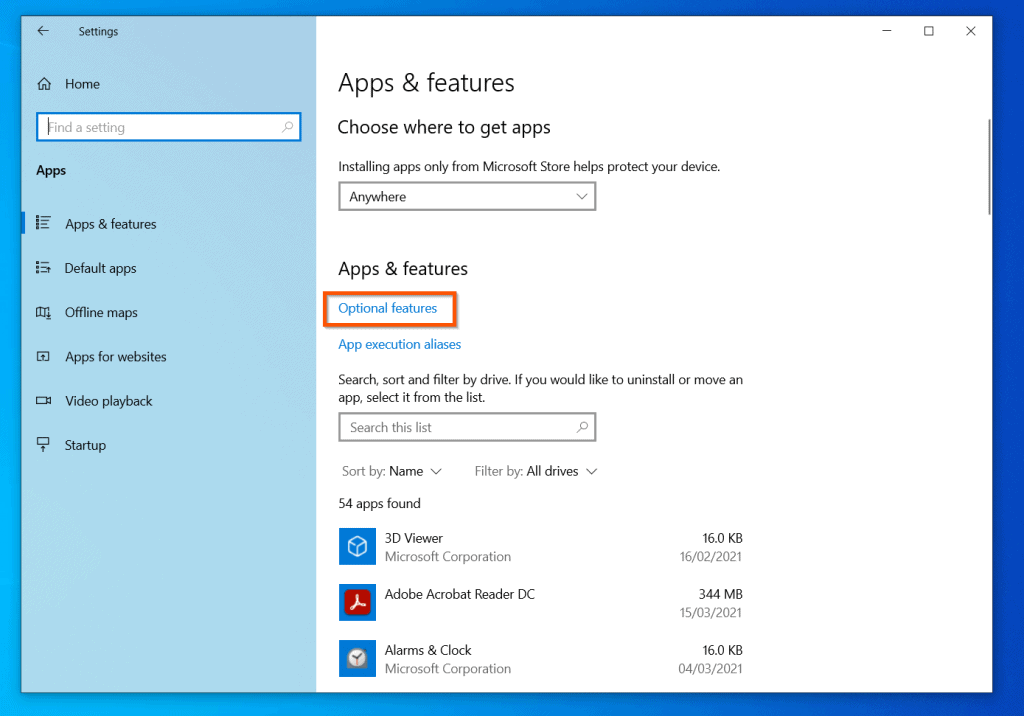
- Then, on the Installed features section, search for media player, click on it – finally, click Uninstall.
If Windows Media Player is not installed, jump to step 5 below…


- If Windows media player is not installed or if it was installed – after uninstalling it – click Add a feature.

- Finally, when the Add an optional feature screen opens, search for media player, check the checkbox beside Windows Media Player – then, click Install.

Wait for the installation to complete, then go back to section 1 above and try opening Windows Media Player with one of the methods. One quick method to open the app is to search for it – see the second screenshot below.


You may also uninstall Windows media player by running DISM /online /disable-feature /featurename:WindowsMediaPlayer command on a command prompt opened as administrator. Additionally, you can reinstall Windows media player by running DISM /online /enable-feature /featurename:WindowsMediaPlayer command on a command prompt opened as administrator

Once you open Windows Media Player in Windows 10, you may discover that the menu is missing. See the screenshot below – the point my arrow is pointing suppose to display the menu.

If Windows Media Player menu is missing – well, maybe not "missing" – more like, "not displayed", right-click anywhere on top of the app. Then, from the displayed options, click Show menu bar.
Alternatively, you can use the keyboard shortcut – pressing the Ctrl and M keys on your keyboard simultaneously.

The Windows Media Player menu – File, View, Play, Tools, and Help – will be displayed.


Need help with Windows 10 Windows Media Player menu? This section walks you through how to use the five menu options – File, View, Play, Tools, and Help.
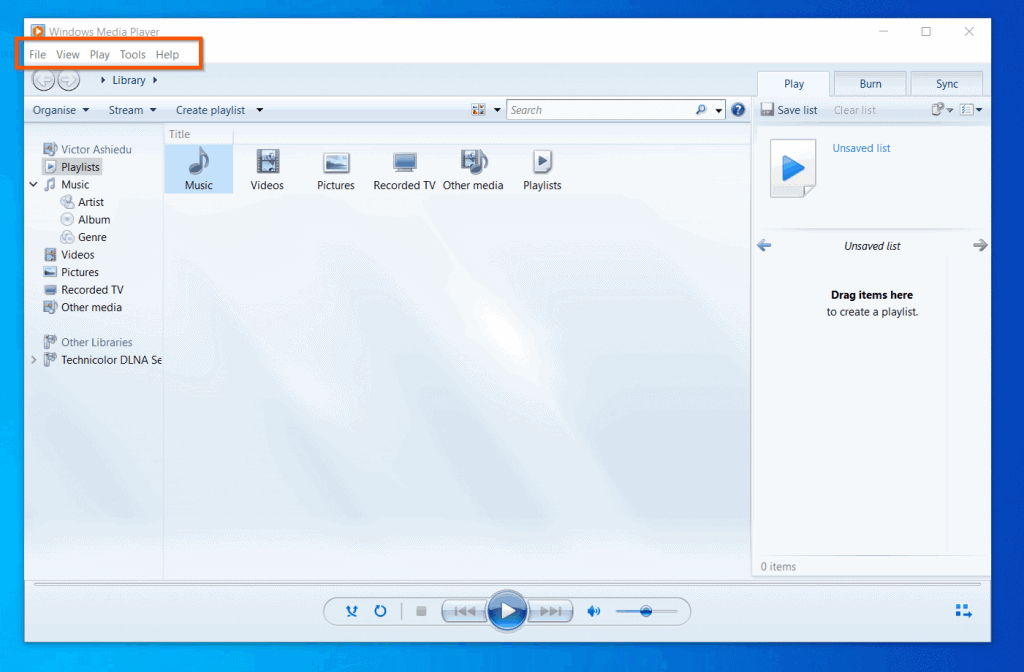
This section is divided into five subsections – covering each of the Windows Media Player menu.
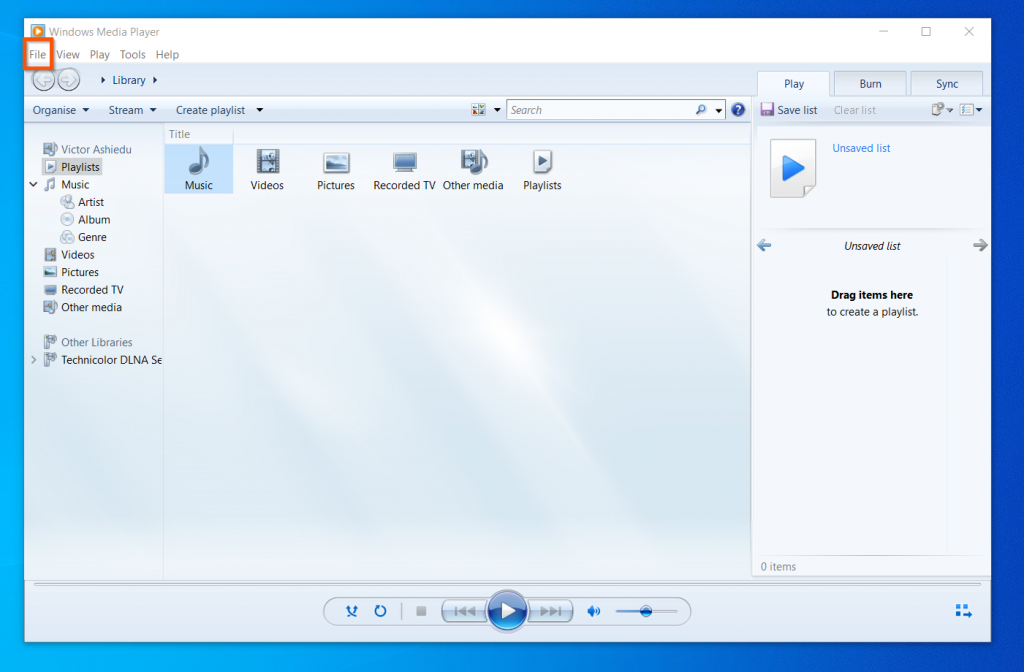
The File menu has additional options. Each item is discussed beneath this screenshot.

Open and Open URl
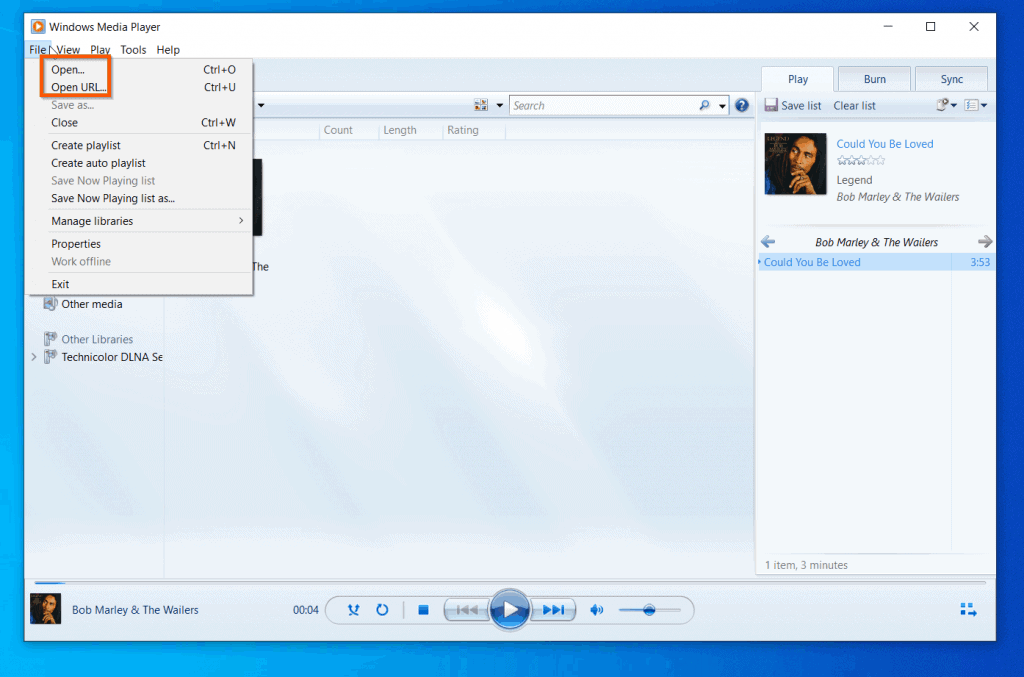
You can use the Open sub-menu to open a music or video file from your computer. When you click Open, it will display a dialogue box.
Navigate to the folder with music or video file, click on a file and click Open at the bottom right of the dialogue box.
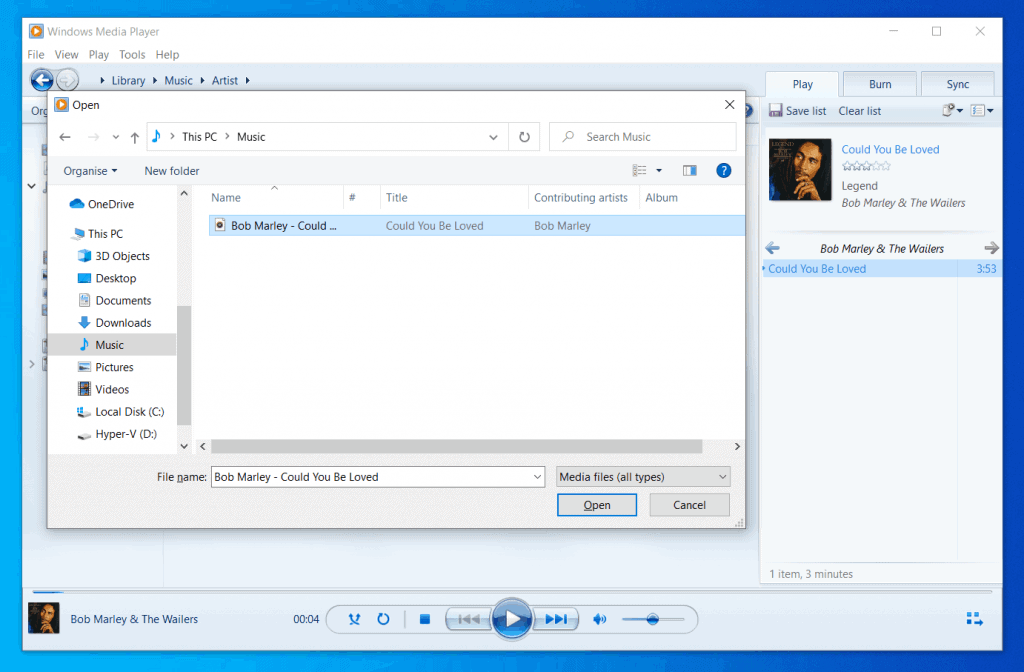
On the other hand, the Open URl sub-menu is used to open a music or video file from a web URL. Follow the steps beneath this screenshot to open a music or video file from a URL.

- Open the URL with the music you want to open. Then, right-click the file download link and select Copy link.
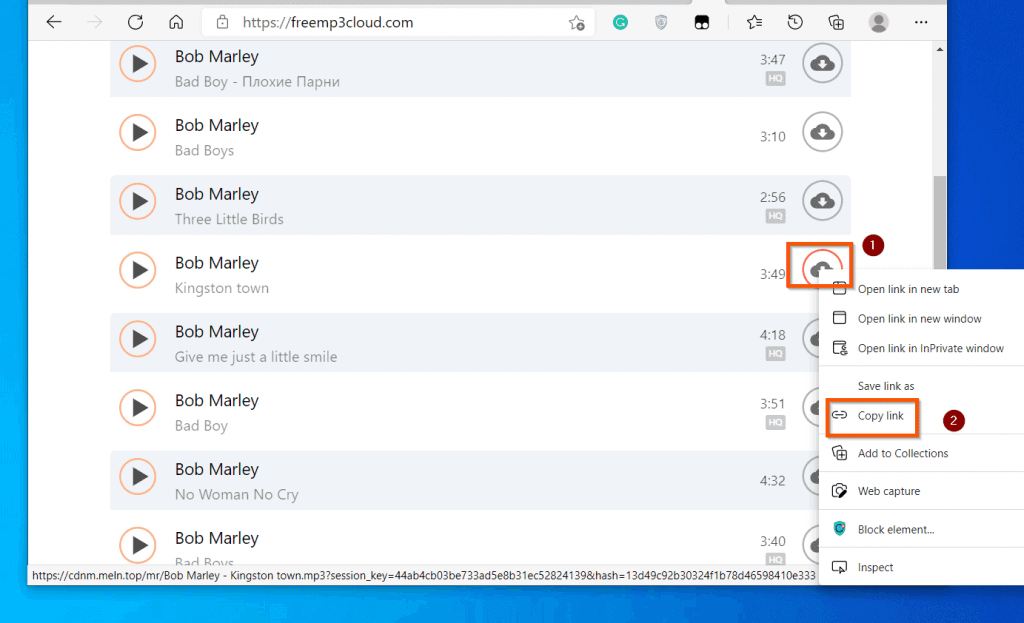
- Back to Windows Media Player, click File -> Open URL

- Finally, paste the link you copied from step 2 in the Open field, then click OK. If Windows Media Player finds a music or video file in the link entered, it will start playing – see the second screenshot below.
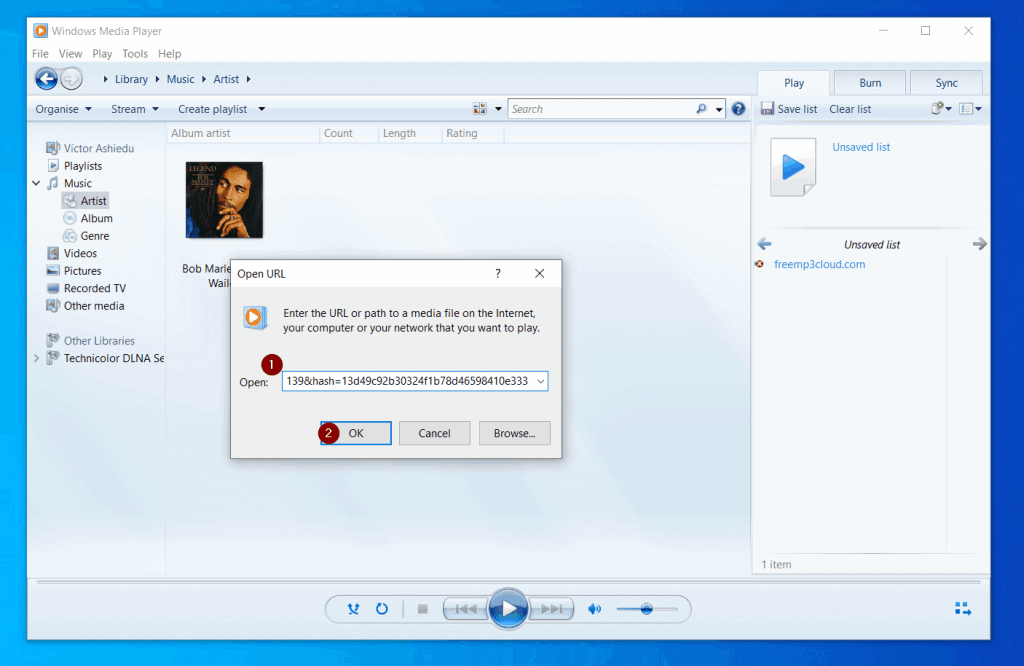

Save As and Close
Next to Open and Open URL in the File menu, are Save as and Close. The Save as sub-menu will only be active if you are playing a music or video from an online link.

To save the media you are streaming via an internet link to your computer:
1. Click File -> Save as.

- Finally, on the Save As dialogue box, select a folder and save the file.
If you are saving a music file, I recommend saving it to the %userprofile%\music folder. Alternatively, if you are saving a video, save it to the %userprofile%\video folder. If you enter any of the folders above in the File name field and click the Save button, the folder will open. When you click Save again, the music file will be saved on your computer.

While you can save streaming music or video with the File -> Save as sub-menu, the Close sub-menu is used to stop what you are playing. To stop stop a playing music or video, click the Close button.

There are more exciting Windows 10 Media Player help with how to use the File menu. To find out more, read on.
Create Playlist and Create Auto Playlist
The use of the "Create playlist" button is straightforward – you use it to create playlist. Additionally, it is easy to use – more on how to use it later in this section.
. The use of the "Create auto playlist" button, however, may not be that straightforward. I will show you how to use this button shortly.

But first, let me show you how to create playlists.
- Click the File menu and select Create playlists. The playlist will be created in the Playlists category with the name


- Rename the playlist to whatever you want to call it. I called mine "Reggae". Once you create a Playlist, you need to add titles to the playlist – see step 3 below.

- To add a song title to your playlist, under Music, click Artists, Album or Genre. Then, right-click any title in any of these categories, point to "Add to", then select your playlist. The title will now be displayed in your playlist.


As I noted earlier, you can also create auto playlists. Unlike a playlist that you have to add titles to manually, an auto playlist automatically adds titles based on specified conditions.
To create auto playlists:
1. Click File and select Create auto playlist.

- Then, on the New Auto Playlist screen, give the new auto playlist a name, set conditions for the playlist and click OK.
In this example, I created an auto playlist called "Bob Marley". Then, I set a conditions "Album artist Is Bob Marley" . These conditions are set by clicking "Click here to add a criteria". See the second screenshot below…


Refer to the screenshot below. The new auto playlist I just created has the only Bob Marley title I have in my Windows 10 Windows Media Player automatically added to the playlist.
After creating an auto playlist, any new title added into your Windows Media Player – that meets the auto playlist criteria – will be added to the playlist.

Manage Libraries
The final sub-menu of the File menu I will discuss is Manage Libraries.

When you hover over the Manage Libraries sub-menu, it displays options to manage Music, Video, Pictures, and Recorded TV libraries.
When you click any of these libraries, you can add or remove folders that Windows Media Player can pick up files from. For instance, you can add or remove new folders.
Here is my Manage Music Library window. The default location that Windows Media Player saves music files is %userprofile%\Music folder. This folder opens to the drive your music folder is located – in the path \Users\<your user name.
To remove this folder click on it, then, click Remove. Additionally, you can add a new folder by clicking the Add button.
Any music file you save in the folders shown here will automatically be displayed in your Music Library.

The first screenshot below shows my default Music library folder, %userprofile%\Music. Note that I have two music files here.
Now, look at my Windows Media Player Music library in the second screenshot below – it shows the same music in the folder. One more thing to note, the %userprofile%\Music folder has a folder called Playlists.
This folder saves all the Music Playlists you create in Windows Media Player.

I have been discussing the Window Media Player "Manage Music Library". All the information provided about the Music library applies to Video, Pictures, and Recorded TV libraries.

As a reminder, this section is still about "Working With Windows Media Player Menu". In the last sub-section I disused the File menu.
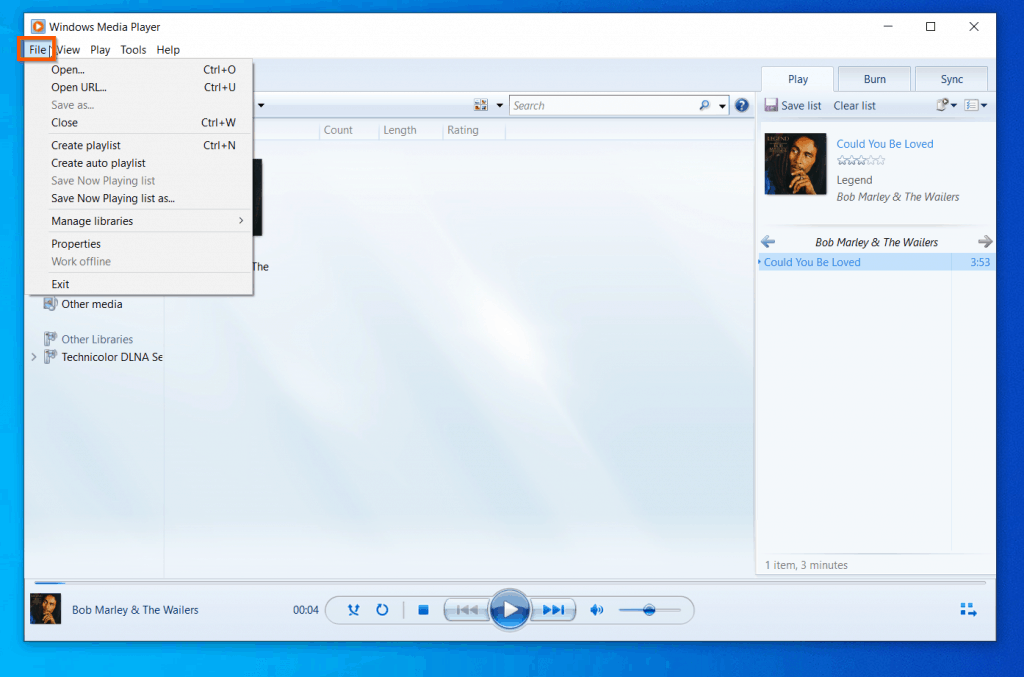
In this sub-section, I will be discussing the View menu.

The View menu may not be as complicated as the File menu. However, it offers equally important features.
While the File menu is used for configuring different aspects of Windows 10 Windows Media Player, the View menu menu controls the appearance of Windows Media Player.
In this section I will show you how to make your Windows Media Player more fun with the different View options. We will start with the default view – Library View.
Windows Media Player "Library" View
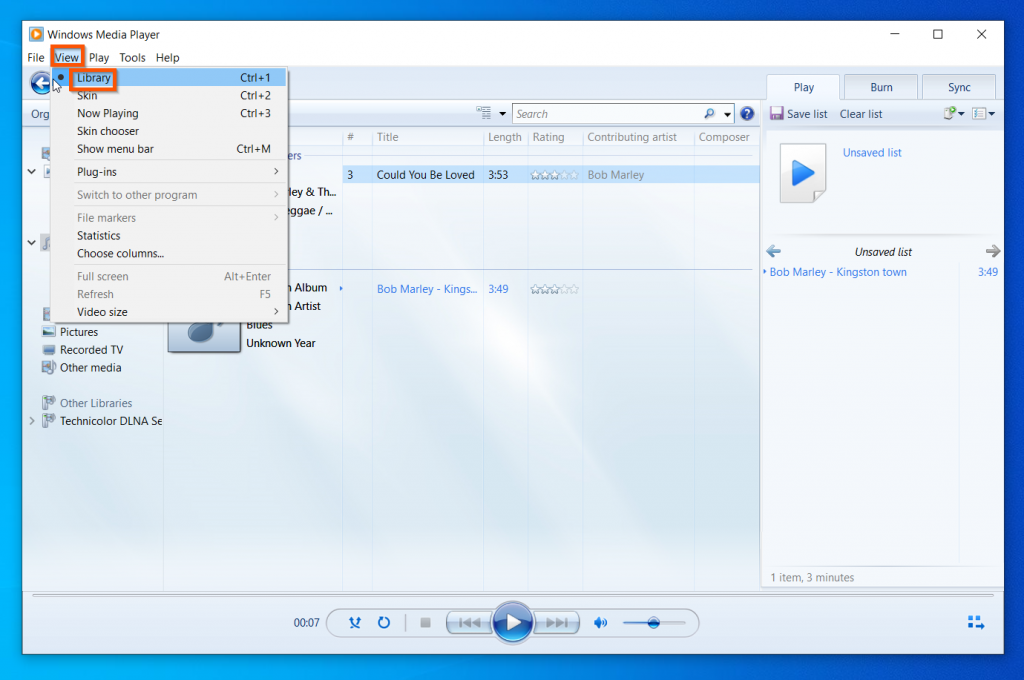
The "Library View" is the default Windows Media Player view. The first column (left pane) of this view displays Playlists, Libraries (Music, Video, Picture, and Recorded TV).
In the middle pane, you have the media titles with all the details about the title. Finally, on the right pane, you have three tabs – Play, Burn, and Sync.
The Play tab of the last pane displays a list of the recent titles you have played. Additionally, if there is a CD/DVD burner connected to your computer, it will be displayed in the Burn tab – you can drag and drop titles you want to burn to CD/DVDs via this tab.
Finally, and equally important is the Sync tab of the last pane of the Library View. If you connect your phone to your computer, Windows Media Library will display the device in the Sync tab.

Windows Media Player "Skin" and "Now Playing" Views

The "Skin View" display a tiny black Window (default) that displays information about the media you are playing. At the bottom of this view you can control the play – fast forward, pause, increase volume, and more.

To return to the default "Library View", click the View menu, then select Library. Alternatively, you can use the keyboard shortcut keys – pressing the Ctrl and 1 keys on your keyboard simultaneously.

Moving on, similarly to the "Skin" view is the "Now Playing" view. To display your Windows 10 Windows Media Player in the "Now Playing" view, click View, then select Now Playing.

The "Now Playing" view looks like the "Skin" view but instead of displaying a Windows Media Player "skin", its displays the album information.

If you hover your mouse over the "Now Playing" view, on the top right, you have an icon – clicking this icon returns Windows Media Player to the "Library" view.
Then, at the bottom of the view, you can stop, rewind, fast forward, and mute the title playing.

Windows Media Player "Skin Chooser"
Windows Media Player skins is a hot help topic most Windows 10 users need help using. Well, here it is! To choose a different skin, click View, then select Skin Chooser.

The Skin Chooser screen displays available Windows Media Player skins. To change to a new skin, on the left pane, click the skin, then click Apply Skin.
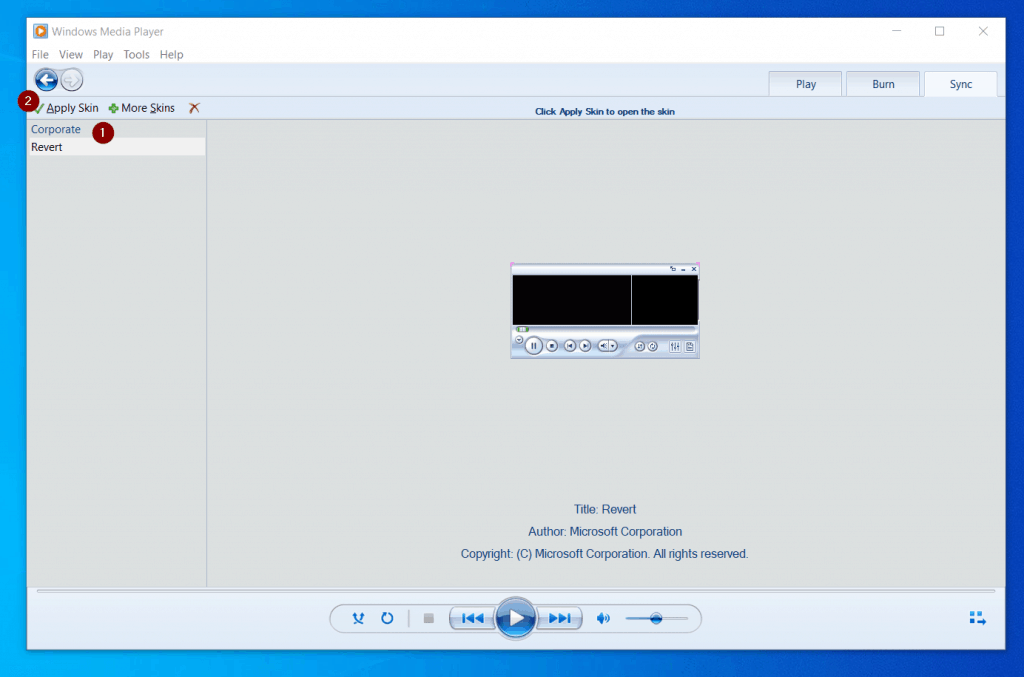
To return to the default "Library" view, click View on the menu, then select Library.
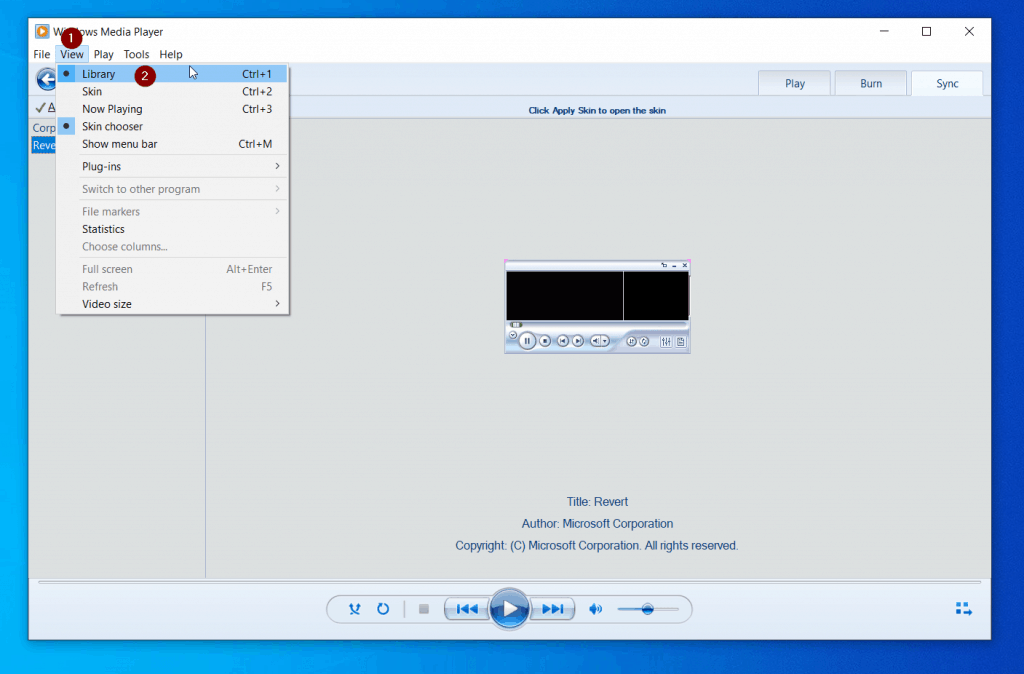
Refresh Windows Media Player, Adjust Windows Media Player Video Size
Before I move on from the "View" tab, I want to show you two more essential features of this tab – Refresh and Video size.

Refresh does exactly what is says – refreshes the items in the Windows Media Player. You can also use the refresh keyboard shortcut – F5.
Another hot Windows 10 Windows Media Player help topic is adjusting video sizes. See available options in the screenshot below.

This section is still discussing "Working With Windows Media Player Menu". The first two sub-sections covered the "File" and "View" menus.

In this sub-section, I will be discussing another Windows 10 Windows Media Player topic – getting help with the "Play" menu!

The simplicity of the "Play" menu does not minimize its importance. You can access the common media play buttons – like Play/Pause, Previous/Next – via the Play menu.

However, the Play view has some other not-so-common buttons like Audio and language tracks and Lyrics, captions and subtitles settings. Finally, you can adjust volume, Shuffle, Repeat and Eject a CD/DVD from the Play menu.

Still discuss the Windows Media Player menu, next is the all important "Tools" Menu.
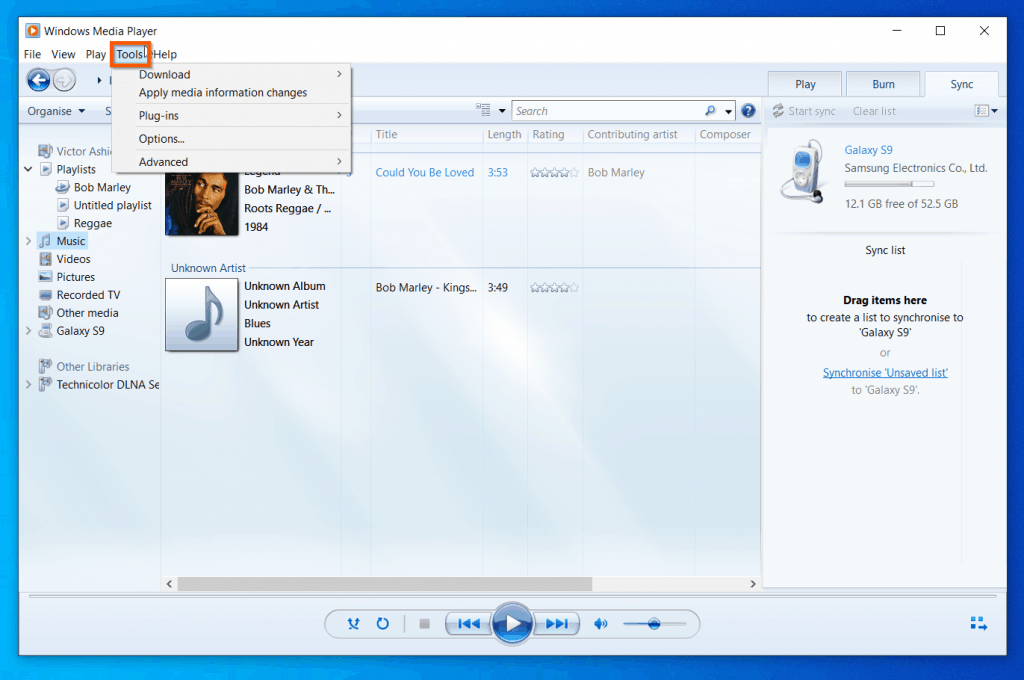
The first sub-menu in the "Tools" menu is Download. If you hover over the Download sub-menu, it displays Visualisations, Plug-ins, and Skins.
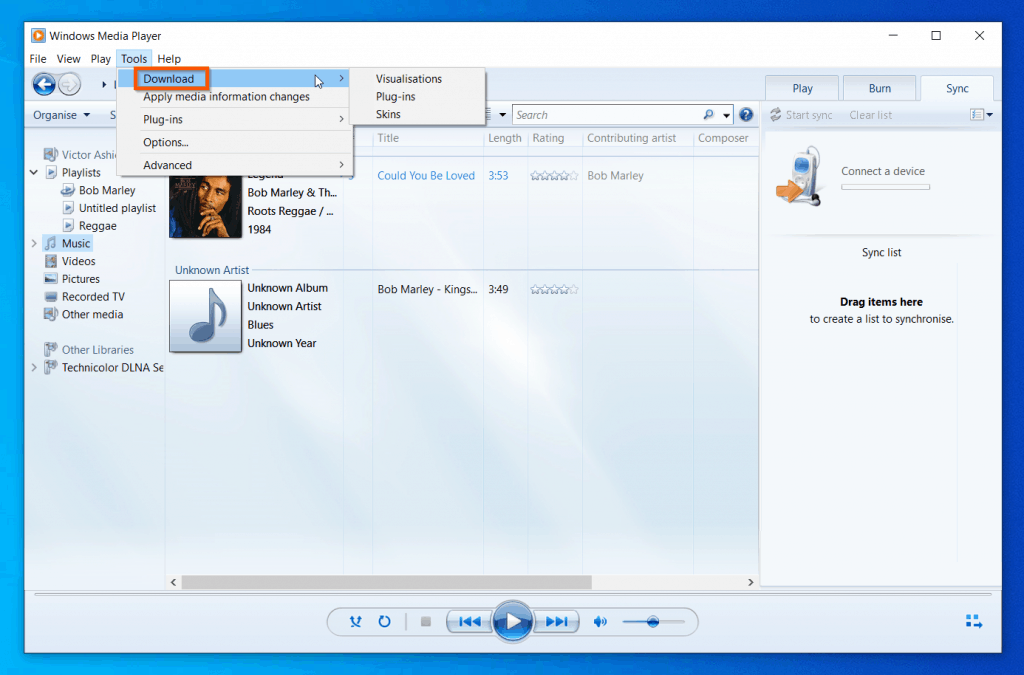
When you click Visualisations, Windows Media Player opens the Visualizations for Windows Media Player (link opens in a new browser tab) page in your default browser. You can download additional Visualizations from this page.

Furthermore, when you click Plug-ins, Windows Media Player opens the Downloads for Windows (link opens in a new browser tab) page in your default browser.

To download plug-ins, click the Windows Media Player plug-ins (link opens in a new browser tab) link.

Moving on, the next Tools menu sub-menu worth mentioning is the Plug-ins sub-menu. This sub-menu has two options – Download plug-ins (which takes you to the same link discussed earlier), and Options.

Use the Plug-ins Options to configure plug-ins and Visualisations (discussed earlier in this sub-section).

There are two more important items in the "Tools" menu – Options and Advanced.

Click Options to change your Windows Media Player settings. To see what you can change, click each tab.

Finally, the Advanced sub-menu allows you to Restore media library and Restore deleted library items.

The final item in the Windows Media Player menu is the Help menu. You can play around the items in the Windows 10 Windows Media Player "Help" menu to get additional help.


You can perform most of the actions discussed so far in this guide with keyboard shortcuts.
The table below is a full list of the Windows Media Player keyboard Shortcuts:
| S/N | Windows Media Player Keyboard Shortcuts | Keyboard Shortcuts Details |
|---|---|---|
| 1 | Ctrl and O keys | OPens the "Open" dialogue box. Also available in the File -> Open menu |
| 2 | Ctrl and U keys | Open the "Open URL" dialogue box. The dialogue box can also be accessed via the File -> Open URL menu |
| 3 | Ctrl and W keys | Stops playing the music or video currently playing |
| 4 | Ctrl and N keys | Create a new playlist. You can also perform this action via File -> Create playlist menu |
| 5 | Ctrl and 1 keys | Displays Windows Media Player "Library" View – also available via the View -> Library menu |
| 6 | Ctrl and 2 keys | Displays Windows Media Player "Skin" View – also available via the View -> Skin menu |
| 7 | Ctrl and 3 keys | This keyboard shortcut displays Windows Media Player "Now Playing" View – also available via the View -> Now Playing menu |
| 8 | Ctrl and M keys | Displays or removes the Windows Media Player menu bar. You can also access this via View -> Show menu bar menu |
| 9 | Alt and Enter keys | Displays Windows Media Player in Full-screen mode. This option is also available via View -> Full screen menu |
| 10 | F5 key | Refreshes Windows Media Player items |
| 11 | Alt and 1 keys | Sets the Windows Media Player video size to 50% |
| 12 | Alt and 2 keys | Sets the Windows Media Player video size to 100% |
| 13 | Alt and 3 keys | Sets the Windows Media Player video size to 200% |
| 14 | Ctrl and P keys | Play/Pause. Also available from the Play -> Play/Pause menu. If a music track or video is playing, pressing Ctrl and P keys pauses the track. Pressing the keyboard shortcut resumes play. |
| 15 | Ctrl and S keys | Stops playing a track or video. This option is also available in the Play menu. |
| 16 | Ctrl, Shift and G keys | Controls Play Speed – plays the track Fast. You can also access this via the Play -> Play Speed menu. |
| 17 | Ctrl, Shift and N keys | Controls Play Speed – plays the track Normal. You can also access this via the Play -> Play Speed menu. |
| 18 | Ctrl, Shift and S keys | Controls Play Speed – plays the track Slow. You can also access this via the Play -> Play Speed menu. |
| 19 | Ctrl and B keys | Plays the Previous track – available in the Play -> Previous menu |
| 20 | Ctrl and F keys | Plays the Next track – available in the Play -> Next menu |
| 21 | Ctrl, Shift and B keys | Rewind. You can also access this from the Play menu |
| 22 | Ctrl, Shift and F keys | Fast forward – also available in the Play menu |
| 23 | Ctrl and H keys | Shuffle – you can also access Shuffle from the Play menu |
| 24 | Ctrl, Shift and C keys | Adjust Lyrics, captions and subtitles settings |
| 25 | F7 key | Mute – also accessible from Play -> Volume menu |
| 26 | F8 key | Volume Down – also accessible from Play -> Volume menu |
| 27 | F9 key | Volume Up – also accessible from Play -> Volume menu |
| 28 | Ctrl and J keys | Eject CD/DVD. You can also eject a CD/CDV by clicking Play -> Eject menu |
| 29 | F1 key | Opens search results for "get help with windows media player in windows 10" in Bing.com |

This section answers frequently asked questions about Windows Media Player In Windows 10.
1. How Do I Get Windows Media Player To work on Windows 10?
If you search Windows Media Player but it is not displayed, from Windows Optional features, uninstall Windows Media Player. Then, reinstall the app.
2. What To Do If Windows Media Player is Corrupted?
Delete all files in the Media Player folder and restart your computer. To the files in the Media Player folder, enter %LOCALAPPDATA%\Microsoft\Media Player in Windows 10 search. Then, select all the files and folders in the Media Player folder and delete them. Restart your computer.
3. Is VLC Media Player Compatible with Windows 10?
Yes, VLC Media Player is compatible with Windows 10. To use VLC Media Player in Windows 10, you have to download and install it.
3. How Do I Uninstall and Reinstall Windows Media Player?
To uninstall Windows Media Player, open command prompt as administrator, enter DISM /online /disable-feature /featurename:WindowsMediaPlayer in command prompt and press enter. When the command completes, at the restart prompt, type Y. Your computer will restart.
To reinstall Windows Media Player, open command prompt as administrator. Then enter the command DISM /online /enable-feature /featurename:WindowsMediaPlayer, and press enter. When the command completes, at the restart prompt, enter Y. Your computer will restart.
4. How Do I Clear My Windows Media Player Library?
Click on the Library item (Music, Video, Picture, or Recorded TV) you want to delete entries from. Then, press Ctrl and A keys to select all items on the selected library. Finally, right-click the items and select Delete.
5. Why Does My DVD Not Play on Windows Media Player?
Windows Media Player in Windows 10 no longer plays DVDs.
6. Is There a DVD Player for Windows 10?
You can download a third-party app from Microsoft Store. One example is Get DVD Player.
7. Where Is Media Player in Windows 10?
There are 3 methods to open Windows Media Player in Windows 10: You can open it by entering Media Player in the Windows 10 search. You can also open Windows Media Player from Start Menu -> Windows Accessories.
8. How Do I Manually Add Music to Windows Media Player Library?
On the top left of Windows Media Player, click the File menu. Then, click Open. Finally, on the "Open" dialogue box, navigate to the folder with the music files and select all with Ctrl + A, then, click Open to add them to Windows Media Player Library.
9. How Do You Play Media Player on a Windows 10 Computer?
Open Media Player by searching for it. Then, click File -> Open. Finally, on the "Open" dialogue box, navigate to the folder with the music files you want to play and select all with Ctrl + A, then, click Open. The music will start playing on Windows Media Player.
10. Is There a Rating for Windows Media Player?
Yes, if you view a music title on the Windows Media Player Music Library, you can click the stars in the Rating column to rate the title. The rating is on a scale of 1 to 5 – 1 star is the lowest rating while 5 star is the highest rating.
I hope you found this Windows 10 Windows Media Player guide helpful? If you found it helpful, kindly voteYesto the "Was this post Helpful" question below.
However, if there is a Windows 10 Windows Media Player help you needed but not included in this guide, click No to the "Was this post Helpful" question below. Then, kindly provide us details of the Windows 10 Windows Media Player help you wanted that is not included in this guide. We review our reader's feedback and update our guides to constantly meet your needs.
Also, take one minute to tell us what you think about this guide – use the "Leave a Reply" form found at the end of this page.
Finally, for more Windows 10 Itechguides, visit our Windows 10 How-To page.
You may also find the following Windows 10 help guides helpful:
Get Help With Notepad In Windows 10: Your Ultimate Guide
Get Help With Paint In Windows 10: Your Ultimate Paint Guide
Help With WordPad In Windows 10: Your Ultimate WordPad Guide
Windows 10 Disk Management: Your Ultimate Disk Management Guide
DiskPart Command Simplified With Examples
- Was this post helpful?
- Yes (8)No (8)
How to Change the Windows Media Player Album Options
Source: https://www.itechguides.com/get-help-with-windows-media-player-in-windows-10/
Posted by: cochranwastat.blogspot.com

0 Response to "How to Change the Windows Media Player Album Options - cochranwastat"
Post a Comment